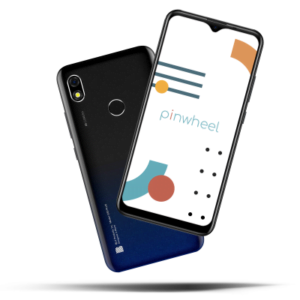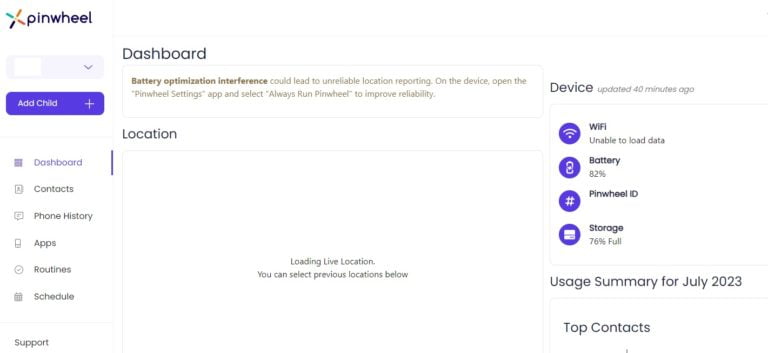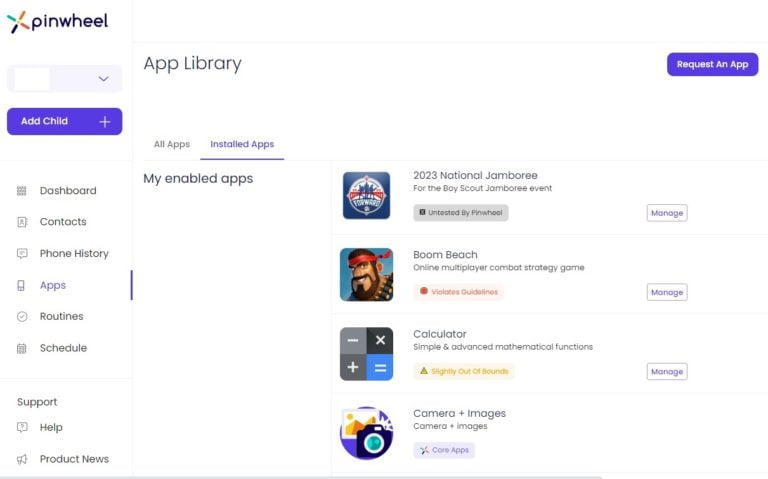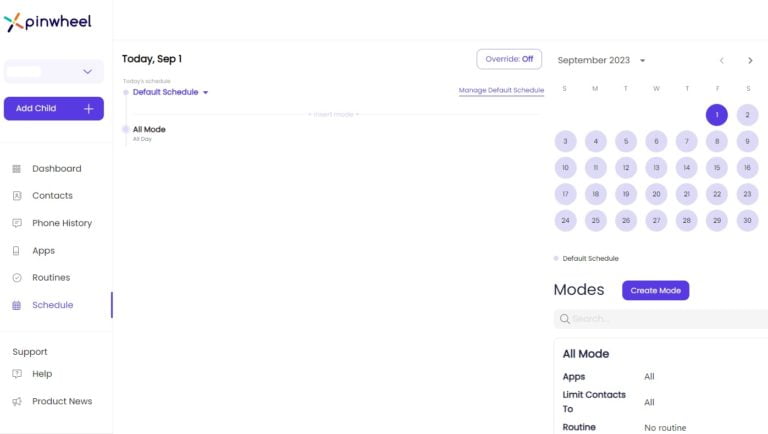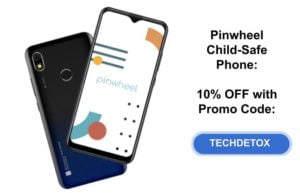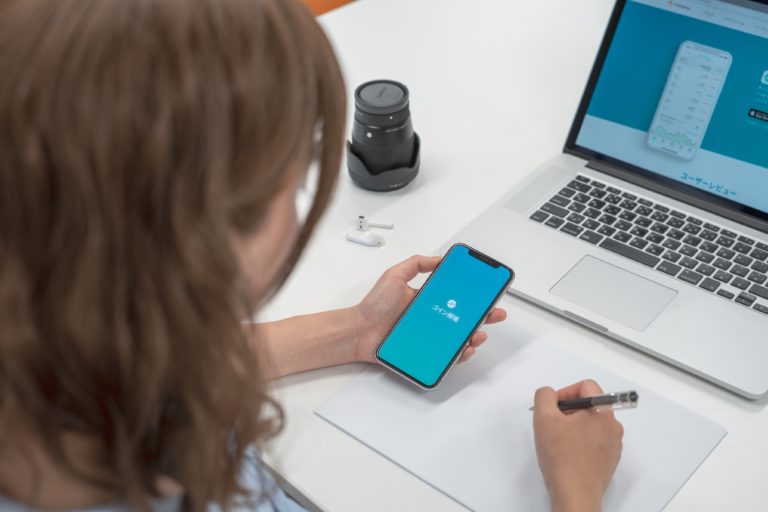We just switched our 17-year old from the child-safe Gabb phone to a parent-managed Pinwheel smartphone to give him more freedom and functionality. This review is our family’s actual experience with the Pinwheel phone. Although the company sent us a free phone, we still have to pay them a monthly service fee as long as our son uses it.
How Pinwheel Phone Works
Our son’s experience with the Pinwheel phone had some highs and lows, but my overall conclusion – it’s a viable option for a teen.
You create a phone login and password for the child, and another login and password for remote phone management through Parental Dashboard. Without these the phone will not work.
Our teen now has apps like Gmail, Spotify, WhatsApp, Kindle Reader, Scratch, and Uber, but no Internet browser or app store. He cannot install apps, only parents can. It’s functionality without distraction and addiction.
Opening links is not an option since there is no browser. If he needs access to the information in the link, he has to email it to himself and open it on the laptop at home during his screen time hours.
Pinwheel’s Caregiver Portal gives parents complete remote access to the phone, managing contacts, apps, and schedules:
Parents can add apps from a pre-approved list of 500+ apps. No social media. No addictive games or ad-driven apps. Allowed apps are each assigned a safety rating:
- Pinwheel Approved
- Slightly Out of Bounds
- Violates Guidelines
- Untested by Pinwheel
It’s up to the parents to decide if the child is ready to use a particular app responsibly. For example, we allowed a couple of simple games to let him learn to balance the use of entertainment apps with communication tools. Parents can manage the usage of each app by setting screen time schedules:
See full list of 500+ apps available for Pinwheel phone.
If the app your child needs is missing, parents can request it.
Here are the apps we installed on our son’s phone:
For communication:
Gmail, WhatsApp, Google Meet, Zoom, GroupMe
For education:
Google Classroom, Google Sheets, Duo Lingo, Scratch (coding app), graphing calculator
For fun:
Spotify, Kindle Reader, a couple of games (Boom Beach, Clash of Clans)
Transportation:
Uber, Google Maps
Tools:
Weather, Clock, Google Translate
The idea is to add functionality to the phone as the child matures. Parent dashboard also allows parents to monitor text messages and call history, set schedules for when contacts and apps are available, and create screen time routines.
How Much Does It Cost?
Our promo code TECHDETOX provides our readers with a 10% discount on Pinwheel phones.
Pinwheel Phones Lineup:
Pinwheel Parental Dashboard monthly fee:
- First Phone: $14.99 monthly ($13.75 if paid annually)
- Additional Phones: $4.99 monthly ($4.58 if paid annually)
Cell Phone Service:
- Whatever you pay your cell phone provider.
Pros and Cons of Pinwheel Phone
PROS
Highly customizable, parents can add apps from the list of 500+
No Internet browser or app store, so no workarounds to parental controls
Takes pictures and videos
No social media communication = no bullying, no drama, no addiction
Has music
No browser = cannot open harmful links
Parents can see all texts on the parent dashboard
If an app becomes distracting, parents can remove it
Looks like a regular smartphone so kids are not embarrassed to use it
Safety features can block texts from unknown numbers
Keep your phone provider. Unlike some other child-safe phones, Pinwheel works abroad
CONS
Some apps (hello Google) are not safe but the child needs them for school
Limited functionality – by design – is frustrating for teenagers
Limited storage, no iCloud
No social media communication = missing out on teen social life
Spotify has inappropriate content
No browser = cannot open useful links
Kids have no privacy from parents
Kids get mad at you for controlling their life
Extra monthly cost of $14.99 for Pinwheel parental dashboard
Can block group texting between friends not in approved contacts
Not all phones work with every provider. Some initial setup glitches. Location services do not always work.
How We Made a Decision
Our family policy always was to delay smartphones as long as possible – as a researcher of tech harms I was well aware of the dangers. The team from Bark (who make their own child-safe Bark phone), an industry leader in protecting children from porn, sexting, suicidal ideation, and bullying, analyzed more than 3.4 billion messages across texts, email, and 30+ apps and social media platforms in 2021, and came up with these alarming statistics:
- Bullying: 72.09% of tweens and 85.00% of teens experienced bullying as a bully, victim, or witness.
- Depression: 32.11% of tweens and 56.40% of teens engaged in conversations about depression.
- Sexual content: 68.97% of tweens and 90.73% of teens encountered nudity or content of a sexual nature.
- Self-harm/suicide: 43.09% of tweens and 74.61% of teens were involved in a self-harm/suicidal situation.
- Drugs/alcohol: 75.35% of tweens and 93.31% of teens engaged in conversations surrounding drugs/alcohol.
- Violence: 80.82% of tweens and 94.50% of teens expressed or experienced violent subject matter/thoughts.
- Predators: 9.95% of tweens and 20.54% of teens encountered predatory behaviors from someone online.
- Disordered eating: 1.96% of tweens and 7.66% of teens engaged with or encountered content about disordered eating.
- Anxiety: 19.69% of tweens and 42.05% of teens used language or were exposed to language about anxiety.
To protect our children from this expanding list of harms, we signed a pledge to delay smartphones at least until 8th grade. Introducing child-safe phones into our kids’ lives became the logical next step – they never had smartphones so they had no basis of comparison. We were not depriving them of smartphone freedom they previously had, but gradually introducing the freedom to arrange their own social lives that comes with phone ownership.
After experimenting with flip phones, we gave our son a basic Gabb phone in 8th grade, which worked well for him but was essentially a basic phone with calls, texts, and location tracking (newer models of Gabb phone now have a choice of child-safe apps).
Today our 14-year old daughter is using Gabb, our 17-year old son is using Pinwheel, and apart from occasional grumbling from the kids everything works. They may be the last teenagers in the state without smartphones, and they are doing ok. Good grades, no anxiety, healthy friendships. Maybe they would be ok with smartphones too, but we decided not to take that risk.
What Do Teenagers Think
Our son started using the phone more now that he had more things to do on it, spending hours reading Kindle books, listening to music, texting with friends, answering emails, and surprisingly, learning a new language on Duo Lingo. However, he still complains about his limited digital options. No App Store. No Internet Browser. Which teenager could be cool with that?!
Our teens are doing reasonably well academically and socially, and I suspect that no smartphone policy has played a part. But withholding the privilege of a smartphone well into their teen years definitely comes at a cost. They want to be like all their friends with smartphones, and they are mad at us for not giving in. They present a thousand arguments why their mom is unreasonable and just plain stupid. I have heard it all:
- “Everyone has a smartphone!”
- “Teachers assign homework on apps!”
- “You don’t understand our generation!”
We chose the lesser of two evils. I would rather have my kids yell at me for being unfair, than expose them to the risks of a fully-loaded smartphone. Our teens think that parents managing their screen time is ridiculous. And our influence on their digital safety is coming to an end: in a year our son will be legally an adult and will make his own choices.
So in response to his complaints, my husband and I told him that he is free to buy his own smartphone (he has a weekend job) and pay for it himself. That’s our last (intentionally built) speed bump on his way to smartphone ownership.
HOWEVER, we would insist on good digital habits as long as he lives under our roof. No phone in the bedroom at night, and in case of tech overuse, WiFi and data privileges can be revoked, if parents are the ones paying for it.
Can I Replace a Smartphone with Pinwheel?
This is a hard decision that usually comes after serious violations of digital safety. It is much easier to start with a child-safe phone. I talked to parents who did the switch, and they say it can be very challenging to roll back from a full smartphone to a parent-managed smartphone like Pinwheel or Troomi or Bark. The backlash can be severe, and the parent-child relationship suffers.
Tech tantrums from a fully grown teenager are not fun.
As I recently learned on Your Undivided Attention podcast, psychologists even started to advise parents against taking the phones away, even if phones are the primary source of mental health problems. Shockingly, in extreme cases taking the phone away could lead to suicide. Kids are so addicted that losing access becomes the last straw.
But a parent-managed smartphone is still a smartphone, so you are not taking the phone away per se, but scaling back the functionality. You sit down together and negotiate which digital tools the child needs to manage their social and academic life, and which apps they would have to live without. It helps to get them onboard by explaining the risks. Mental health issues from toxic social media. Failing to become an adult because of addictive gaming. Porn ruining their sexuality. No guarantees they would listen but at least you let them know you are motivated by love.
Teenagers deserve more freedom in their tech usage, no question about that. But we need to remember that biologically a brain is not fully mature until the age of 25, and in case of ADHD diagnosis – after 30. Immature brain is no match for addictive technology.
So while our son is still in high school, we make a reasonable effort to protect his transcript from YouTube binges. Homework needs to be submitted on time. Night is for sleeping, not gaming. It’s not easy to micromanage a frustrated adolescent who craves autonomy. As he gets older, we interfere less and less, but we are not hands off yet.
I don’t know if we are doing things right. I only know that we have our kids’ best interests at heart, and Google does not.
Let’s put your phone to charge downstairs. Good night, son. We love you.
Share this:
- Click to share on X (Opens in new window) X
- Click to share on Facebook (Opens in new window) Facebook
- Click to share on LinkedIn (Opens in new window) LinkedIn
- Click to share on Pinterest (Opens in new window) Pinterest
- Click to email a link to a friend (Opens in new window) Email
- Click to print (Opens in new window) Print

